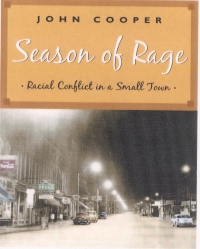| ________________
CM . . .
. Volume XI Number 12 . . . .February 18, 2005
excerpt:
In Season of Rage, John Cooper paints a picture of small-town Ontario in the 1950s. Dresden was geographically far from the civil-rights protests that were brewing in the southern United States. This did not mean, however, that the racist attitudes held by some white business owners in town did not resemble those of their southern counterparts. Cooper begins by briefly outlining the major events in the history of black slavery in America, starting in 1619 with the arrival of the first African slaves in the Virginia settlement. He does this very effectively by presenting the information in a timeline. This simple format provides dates and major events quickly and helps to set the scene for the story to follow. Some events on the timeline are highlighted and given a paragraph or an illustration to help give a little bit more context. From here, the reader is moved to Dresden, Ontario. Dresden's history as a busy trading spot with fertile farmland is described while Cooper explains how slaves, many of whom had found their way to Canada along the Underground Railroad, came to settle near this town in the southwestern corner of Ontario. In 1840, a group of slaves, along with abolitionists and Quakers, bought some land near Dresden and established a settlement where people worked as farmers, or at the sawmill or the brickyard. Many students learn about Harriet Tubman and her heroic trips helping slaves make their way along the Underground Railroad to Canada—where slavery was illegal. What these same students might not learn is explored in this book. Racist attitudes towards Blacks were openly held in the United States, but they were also present all across Canada. Cooper deals with this issue with sensitivity, but without flinching from the truth that Blacks in Canada were not given equal treatment with their white neighbours—even as recently as 50 years ago. The rest of Cooper's book explores this unequal treatment, giving readers the history of a town and several characters whose certainty in their beliefs caused protests and friction on the streets in "Everytown, Ontario." Cooper introduces the National Unity Association, an organization that arose after Hugh Burnett's complaint letter to the Canadian government in 1943 was ignored. This group of concerned citizens realized that the National Unity Association could have more impact than Burnett ever would as an individual. Cooper has clearly done a lot of research into the people involved in the protests as well as the various trials of Morley McKay, the caf‚ owner who continued to refuse service to Blacks even after being charged under the Fair Accommodation Practices Act. The story wraps up with a chapter devoted to the fate of Burnett and other characters in the story. Unfortunately, Burnett's business suffered as a result of his activities, and he was forced to move away from Dresden to make his living. The book concludes with a civil-rights timeline. As with the timeline of slavery, Cooper keeps to the facts here and, at the same time, gives readers a look at the history of the period from 1941 until Martin Luther King Jr.'s death in 1968. Cooper's goal is to tell the story of an individual who worked to make changes in a seemingly unchangeable system. With the clear and simple writing style and thorough research, Cooper has succeeded not only in telling the story but in making this book a compelling read. Various photos peppered throughout the chapters bring a visual impact to the printed information. This book is an important addition to school and public libraries' collections of Black Canadian and civil-rights history. Highly Recommended. Grace Sheppard is a Children's Librarian with the Ottawa Public Library in Ottawa, ON.
To comment
on this title or this review, send mail to cm@umanitoba.ca.
Copyright © the Manitoba Library Association. Reproduction for personal
use is permitted only if this copyright notice is maintained. Any
other reproduction is prohibited without permission.
NEXT REVIEW |
TABLE OF CONTENTS FOR THIS ISSUE
- February 18, 2005.
AUTHORS |
TITLES |
MEDIA REVIEWS |
PROFILES |
BACK ISSUES |
SEARCH |
CMARCHIVE |
HOME |
